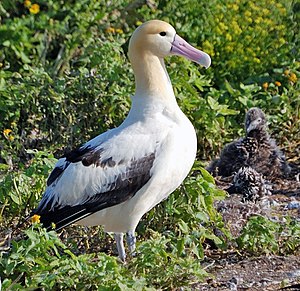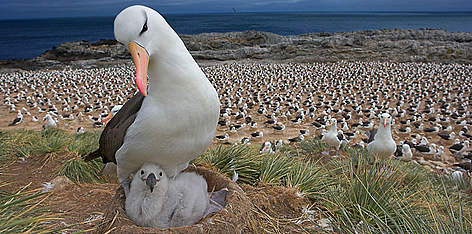By: Jeremy Suryadi
Description and Ecology
The Short-Tailed Albatross is one of the rarest seabirds of the Northern Pacific Ocean (Porcassi 1999). Just one of three other albatross in the area. It is one of the most distinct looking birds. It belongs to the Diomedeidae family, order Procellariiformes (American Ornithologists' Union 1998). The Short-Tailed pink bill is disproportionately large compared to other albatross. Of the three North Pacific Albatross, it's the largest in terms of body length, wingspan, and body mass.
 |
Other than foraging the Pacific Ocean for food, it nests on remote Japanese Islands. The albatross usually returns to its same nesting area. Their diet consists of squids, shrimp, and small fishes (Porcassi 1999).
Geographic and Population Changes
Prior exploitation, the albatross ranged throughout the North Pacific Ocean and Bering Sea, and still does today (Olson and Hearty, 2003). Specifically, the albatross exists as west as Japan to as far east as Alaska and Hawai'i (Sekora 1977, Fefer 19889). Currently, the albatross nests on four islands: the majority on Torishima, Japan, the rest on Minami-kojima in the Senkaku Islands.
Pre-exploitation population isn't known. Beginning in the late 19th century population did decline. Between 1885 and 1903 approximately 5 million albatross were harvested (Austin 1949). On Tiroshima 300,000 breeding pairs were extirpated. By 1949 there were no albatross in breeding sites like Tiroshima. After careful investigation, 2007-2008 total worldwide population is 2,406 (Hasegawa, Toho Univ.).
Listing Date and Type of Listing
The Short-Tailed Albatross was listed in 1970, under the Endangered Species Conservation Act of 1969. It was officially listed as endangered throughout its range July 31, 2000.
Cause of Listing and Main Threats to Continued Existence
The original cause of albatross decline was commercial feather hunting. However, unlike most organisms on the ESA, this primary threat no longer occurs. There are still a number of factors threatening existence and recovery. On Tiroshima the presence of volcanic eruptions and monsoon rains create habitat degradation and destruction (Finkelstein 2007). Also, competition from the other two North Pacific Albatross dampen recovery. Although the Short-Tailed Albatross is subjected to destructive fishing lines from vessels, there would have to be a 5-7% increase in additional mortality to have an actual impact on their population (World Wildlife Fund). Because of the remoteness of their nesting grounds, the albatross is not affected by invasive plants and animals.
Description of Recovery Plan
Torishima population monitoring has occurred annually since the mid-1950s. In addition, all chicks have been color-banded since 1979 (Toho Univ.). Because of Torishima's instability, breeding site enhancements and transplants have been attempted. In terms of enhancement, grass transplants and soil stabilization were employed; breeding success followed quickly (Hasegawa 1991). In 2006, biologists tried translocating Short-Tailed Albatross from Midway-near Hawai'i- to the island of Kauai. Nest improvement and translocating remain the primary methods of recovering the Short-Tailed Albatross. Unlike most endangered species, many recovery actions will be conducted outside the U.S.





No comments:
Post a Comment